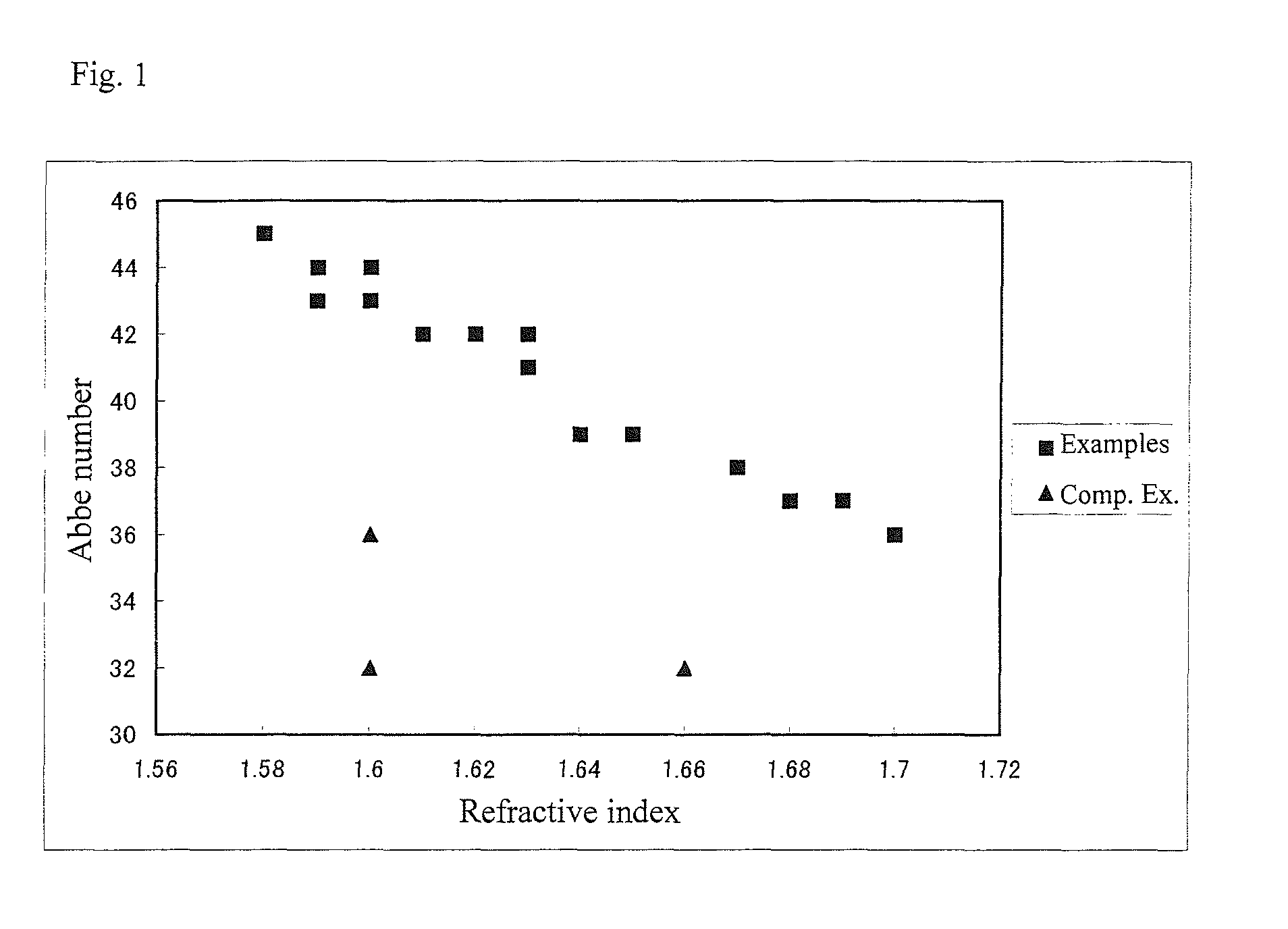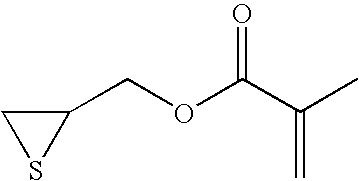Resin composition for optical member and optical member obtained from the same
a technology of optical components and resins, applied in the field of resin compositions for optical members and optical members, can solve the problems of not being easy to obtain resins from compositions formed of any of such compounds, no material having better properties has been put into practice, and the functional groups usable as comonomers are limited, etc., to achieve the effect of low specific gravity, light resistance, heat resistance and strength
- Summary
- Abstract
- Description
- Claims
- Application Information
AI Technical Summary
Benefits of technology
Problems solved by technology
Method used
Image
Examples
example 1
[0118]To 100 parts by weight of thioglycidylmethacrylate (the compound of formula (1) in which X is O and Y is a methacryloyl group; hereinafter, referred to simply as “TGMA”), 0.2 parts by weight of tetrabutylphosphoniumbromide and 0.5 parts by weight of tert-butylperoxyneodecanoate as catalysts were added. These components were stirred at room temperature to obtain a uniform liquid. Next, the resultant liquid was deaerated at 10 torr for 10 minutes, then filtrated, injected into a mold for lens, and polymerized and cured by raising the temperature from 30° C. to 110° C. over 22 hours in an oven. Then, the resultant substance was removed from the mold and heated at 110° C. for 1 hour to be annealed. The obtained lens was transparent and had a good external appearance. The optical properties and the like were measured. The results are shown in Table 1.
examples 2 through 9
[0119]Lenses were obtained by polymerization and curing performed in substantially the same manner as in Example 1 using the compositions and the catalysts shown in Table 1. The obtained lenses were transparent and had a good external appearance. The optical properties and the like were measured. The results are shown in Table 1.
TABLE 1Refrac-Exam-CompositionCatalysttiveAbbeple(parts by weight)(parts by weight)indexnumber1TGMA = 100TBPB / PBND = 0.2 / 0.51.58452TGMA = 100MI / POO = 1.0 / 1.01.58453TGMA = 100TBP / PBO = 1.0 / 3.01.58454TGMA = 100BE / POO = 0.1 / 0.11.58455ATGE = 100BE / PBO = 0.1 / 0.51.59446ATGE = 100EBAC / AIBN = 0.2 / 0.51.59447TSMA = 100MI / POO = 1.0 / 1.01.63428ATSE = 100MI / POO = 1.0 / 1.01.64429TGMA = 100BE = 0.11.5845
Abbreviations for the compounds in Table 1
TGMA: Thioglycidylmethacrylate; the compound of formula (1) in which X is O and Y is a methacryloyl group
ATGE: Allylthioglycidylether; the compound of formula (1) in which X is O and Y is an allyl group
TSMA: Thioglycidylthiomethacryla...
example 10
[0126]To 90 parts by weight of thioglycidylmethacrylate as (a) a compound having one or more of any group selected from the group consisting of an acryloyl group, a methacryloyl group, an allyl group and a vinyl group and one or more β-epithiopropyl groups in a molecule and 10 parts by weight of bis(β-epithiopropyl)sulfide as (b) a compound having one or more β-epithiopropyl groups in a molecule while having no polymerizable unsaturated bond group, 0.3 parts by weight of N-methyl-2-mercaptoimidazole and 1.0 parts by weight of 1,1,3,3-tetramethylbutylperoxy-2-ethylhexanoate as catalysts were added. These components were stirred at room temperature to obtain a uniform liquid. Next, the resultant liquid was deaerated at 10 ton for 10 minutes, then filtrated, injected into a mold for lens, and polymerized and cured by raising the temperature from 30° C. to 110° C. over 22 hours in an oven. Then, the resultant substance was removed from the mold and heated at 110° C. for 1 hour to be ann...
PUM
| Property | Measurement | Unit |
|---|---|---|
| Fraction | aaaaa | aaaaa |
| Fraction | aaaaa | aaaaa |
| Percent by mass | aaaaa | aaaaa |
Abstract
Description
Claims
Application Information
 Login to View More
Login to View More - R&D
- Intellectual Property
- Life Sciences
- Materials
- Tech Scout
- Unparalleled Data Quality
- Higher Quality Content
- 60% Fewer Hallucinations
Browse by: Latest US Patents, China's latest patents, Technical Efficacy Thesaurus, Application Domain, Technology Topic, Popular Technical Reports.
© 2025 PatSnap. All rights reserved.Legal|Privacy policy|Modern Slavery Act Transparency Statement|Sitemap|About US| Contact US: help@patsnap.com



